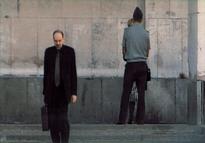HANS VAN DEN BROECK
The choreographer, dancer, performer and filmmaker Hans Van Den Broeck is a member of the dance collective Les Ballets C. (Contemporaines) de la B. (Belgique). His dance theatre productions and videos - radical, ’unfinished’ works that focus on small particulars - reveal a strong interest in group psychology and the position of the individual within closed communities. Hans Van Den Broeck studied psychology at the University of Leuven and then film at the University of New York. Although he only practised the profession of psychology for a short time, his art work is clearly rooted in this science. As a self-taught dancer he took his first steps with Les Ballets C. de la B., the artists’ collective surrounding the choreographer and dramatist Alain Platel. Van Den Broeck, together with Platel, Koen Augustijnen and Christine Desmet, has formed the artistic core of the company since 1988. Van Den Broeck’s first dance production, How to Approach a Dog, in which his most important interests immediately became apparent, was premiered in 1992.
Strongly influenced by Jan Fabre’s stage work, Van Den Broeck’s performances are an attempt at investigating animality and cruelty, psychological aspects that people develop mainly in groups. These aspects also crop up in other stage productions, including Eat, Eat, Eat (1996), La Sortie (1999) and Lac des Singes (2001): each time, the choreographer isolates a group of people in a closed space. Waiting for their often indefinable finales, Van Den Broeck observes his personages and the claustrophobia that comes with the forced togetherness. In an apparently unfinished form, the choreographer keeps zooming in onto moments: he takes the particular as his departure point, pays a lot of attention to the absurd and the detail and works around general findings from psychology. What chiefly count are the content and the collisions of the characters. Although the aesthetic form is present, he makes a logical progression from the reflective working process of the choreographer with his team of dancers. His performances thus contain nods to television and film, for example, to pop music and even to a conjuring show: iconic references that are particularly meant to underline the isolation of his personages.
Besides being a choreographer and dancer, Hans Van Den Broeck is also active as a creator of exhibitions, as an installation artist and as a filmmaker. The same points of view and techniques appear in his video films as in his dance theatre performances. For Our Circumscribed Days (2000), for example, he spent a summer in Moscow with his digital video camera. The initial intention to make a portrait of the city and its inhabitants - a series of shots intended to provoke situations - ended up as a simple recording: the video film presents itself as an observation in which the director almost degenerates into a voyeur of the city. Van Den Broeck concentrates on dialogues that get out of hand and on the phenomenon of waiting, which, it seemed to him at the time, has been ’elevated to an occupation in Russia’. Using a sober, documentary style, Van Den Broeck plays with rhythm, with the surreal qualities of daily life and with the inhabitants who evolve into metropolitan actors. Conflicts, absurdities and funny situations - however small - are all given precedence again. Van Den Broeck was guided and inspired by the short stories of Daniil Charms, whose rhythmic, almost incantatory style of writing is echoed in the sharp registration of Our Circumscribed Days with its slowly pulsating choreography constructed from everyday actions.

- ° 1964 Belgium. Lives and works in Brussels.
-
Links
-
EVENEMENTEN
-
At view in the media library
WERKEN